|
The
|
||||||||||||||||||||||||||||||||||||||||||||||||||||||||||||||||||||||||||||||||||||||||||||||||||||||||||||||||||||||||||||||||||||
THE BURGENLAND BUNCH NEWS - No. 251 January 31, 2015, © 2015 by The Burgenland Bunch All rights reserved. Permission to copy excerpts granted if credit is provided. Editor: Thomas Steichen (email: tj.steichen@comcast.net) Archives at: BB Newsletter Index Our 19th Year. The Burgenland Bunch Newsletter is issued monthly online. It was founded by Gerald Berghold (who retired Summer 2008 and died in August 2008). |
||||||||||||||||||||||||||||||||||||||||||||||||||||||||||||||||||||||||||||||||||||||||||||||||||||||||||||||||||||||||||||||||||||
Current Status Of The BB: * Members: 2308 * Surname Entries: 7545 * Query Board Entries: 5404 * Staff Members: 17 |
||||||||||||||||||||||||||||||||||||||||||||||||||||||||||||||||||||||||||||||||||||||||||||||||||||||||||||||||||||||||||||||||||||
This newsletter concerns: 1) THE PRESIDENT'S CORNER 2) LOCKENHAUS TRIP REPORT (by Kathryn Augustin) 3) THE AUSTRIAN WAR ARCHIVES IN VIENNA (KRIEGSARCHIV WIEN) 4) MEMOIR OF RAYMOND BUBICK (Part 2) 5) USING PATTERNS TO FIND AN UNKNOWN (by Margaret Kaiser) 6) HISTORICAL BB NEWSLETTER ARTICLES: - NEUHAUS AM KLAUSENBACH - REVIEW TRANSLATION OF VILLAGE HISTORY 7) ETHNIC EVENTS 8) BURGENLAND EMIGRANT OBITUARIES (courtesy of Bob Strauch) |
||||||||||||||||||||||||||||||||||||||||||||||||||||||||||||||||||||||||||||||||||||||||||||||||||||||||||||||||||||||||||||||||||||
1) THE PRESIDENT'S CORNER (by Tom Steichen)  Concerning
this newsletter, after the bits and pieces here in my "Corner," our first full-length article,
member Kathryn Augustin provides us a Trip Report to Lockenhaus. Concerning
this newsletter, after the bits and pieces here in my "Corner," our first full-length article,
member Kathryn Augustin provides us a Trip Report to Lockenhaus.In Article 3, I write about the Austrian War Archives in Vienna, otherwise known as the Kriegsarchiv Wien. Includes is information about other War Archives in the Austro-Hungarian successor states. Article 4 completes the Memoir of Raymond Bubick, who died in October 2014. Born in South Bend, IN, in 1933, Ray was a child of between-the-wars Burgenland emigrants. Article 5 is from Margaret Kaiser, who writes about Using Patterns to Find an Unknown to solve a tough search problem. The remaining articles are our standard sections: Historical Newsletter Articles, and the Ethnic Events and Emigrant Obituaries sections. 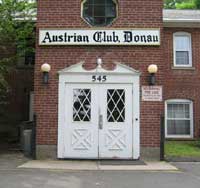 “Wall
of Honor” Contemplated: A "virtual" Wall of Honor is being considered for
implementation by the Austrian-Donau Club to commemorate the lives of Burgenländers and
other Austrians who settled in the New Britain area of Connecticut. The undertaking is the
brainchild of Dennis Kern, whose parents came from the Jennersdorf area of Burgenland and its
environs. Dennis has been the President of the club for nearly 10 years. “Wall
of Honor” Contemplated: A "virtual" Wall of Honor is being considered for
implementation by the Austrian-Donau Club to commemorate the lives of Burgenländers and
other Austrians who settled in the New Britain area of Connecticut. The undertaking is the
brainchild of Dennis Kern, whose parents came from the Jennersdorf area of Burgenland and its
environs. Dennis has been the President of the club for nearly 10 years.Many of the Burgenland immigrants who came to Connecticut settled in the New Britain area. Most came from the Jennersdorf Bezirk and surrounding areas in the period from the 1890s through the 1920s. The people who came were industrious and worked in the many factories in the area, or were local shopkeepers. They lived alongside one another in the downtown area of New Britain. The immigrants wanted to maintain their contact with family and friends and, as a result, formed a club where they gathered regularly to sing the songs of the Heimatland and to socialize with one another. The beginning of the club dates back to Feb. 6, 1905. It started as the Gesangverein Oesterreich, consisting of 10 singers who practiced in the home of their conductor, A. Kuhn, on Arch Street. The first president of the club was John Ruck, who came from Minihof-Liebau. The club still serves as a gathering place for Burgenland descendents who want to keep traditions alive. The "virtual" Wall of Honor, to be added to the club website if implemented, will include the names of immigrants plus photos and other memorabilia for individuals who made the trek to America and settled in New Britain. Dennis says, "it is our way of recognizing and commemorating the lives of our ancestors." We commend Dennis for considering this project and encourage others to consider creating local memorials in their areas too! Bauer sucht Frau (Farmer Wants A Wife): I don't know whether I should laugh or be serious about this item... you decide, OK?  A
message has come to me through the offices of the BG and Bob Strauch that the producer (UFA
Factual GmbH) of the Austrian TV show, "Bauer sucht Frau," is looking for an
Austrian-born person with an agricultural background that is farming outside of Austria and
would like to be on their reality show. The show is hosted by Arabella Kiesbauer and attempts to
assist a farmer (male or female) with their search for a partner. A
message has come to me through the offices of the BG and Bob Strauch that the producer (UFA
Factual GmbH) of the Austrian TV show, "Bauer sucht Frau," is looking for an
Austrian-born person with an agricultural background that is farming outside of Austria and
would like to be on their reality show. The show is hosted by Arabella Kiesbauer and attempts to
assist a farmer (male or female) with their search for a partner.The show is in its 12th season (amazing as that is!) and is looking for new ideas, which is why they seek an Austrian-born person from abroad to participate. If interested, you can contact them by mail (UFA Factual GmbH, Eiswerder Straße 18, 13585 Berlin, Germany), email (katrin.deller@ufa-show.de) or phone (+43699/11003661). FamilySearch.org December Additions: As I've noted in the past, FamilySearch.org continues to add genealogical records, either as indexed records or as digital images, and to both new and existing collections. The month of December 2014 had three announcements on the organization's blog about such additions, which I have collected below into a single table. While none of the additions apply directly to Burgenland, there is likely something for everyone in these additions, as there were over 136 million items added, including some 8 million digital images. Foremost among them were the 124 million indexed records from the Find-A-Grave collection. Surely someone in your family has been memorialized therein! Regardless, my purpose in providing this update is to remind you that new online resources appear every week, so don't give up your search! I wish you good hunting (genealogically) in 2015!
|
||||||||||||||||||||||||||||||||||||||||||||||||||||||||||||||||||||||||||||||||||||||||||||||||||||||||||||||||||||||||||||||||||||
2) LOCKENHAUS TRIP REPORT (by Kathryn Augustin) 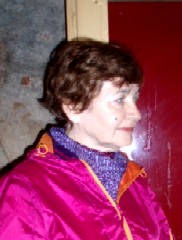 Before
traveling to Lockenhaus, Austria, (Léka, Vas, Hungary, when my paternal grandparents were born),
a Burgenländer emailed me the Augustin portion of this town’s phone book. When I visited
the Lockenhaus graveyard, the man who owned the flower shop occupied the newest Augustin grave.
I had counted on dropping into his shop... but he died in 2012. The three other Augustin
names were women. I was not bold enough to knock on the doors of “strangers.” Before
traveling to Lockenhaus, Austria, (Léka, Vas, Hungary, when my paternal grandparents were born),
a Burgenländer emailed me the Augustin portion of this town’s phone book. When I visited
the Lockenhaus graveyard, the man who owned the flower shop occupied the newest Augustin grave.
I had counted on dropping into his shop... but he died in 2012. The three other Augustin
names were women. I was not bold enough to knock on the doors of “strangers.” Few people were about. I talked with some men in the graveyard but none knew my grandfather’s family, even though over a quarter of the tombstones were Augustin. My German is poor. The police/city hall building seemed empty as we wandered through and the tourist office only wanted to sell tickets to the castle and talk about the crypts in the church; 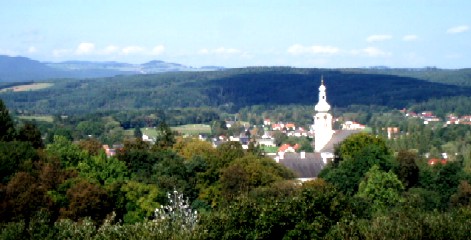 the
idea of finding ancestors seemed foreign to her. Our waitress was friendly but did not know the
three Augustin ladies living within a short walking distance from the restaurant. The
town was small but there are two extensions along the main highway, Weinerstrasse. Still, I was
thrilled to walk the steps and interior of the church where my grandparents were baptized, as
were countless family members. the
idea of finding ancestors seemed foreign to her. Our waitress was friendly but did not know the
three Augustin ladies living within a short walking distance from the restaurant. The
town was small but there are two extensions along the main highway, Weinerstrasse. Still, I was
thrilled to walk the steps and interior of the church where my grandparents were baptized, as
were countless family members.Lockenhaus had been a Roman outpost and the town was on the path the Turks used to lay siege to Vienna (Wien). There is no way to know how long the Augustin family had resided there. When villages were entirely sacked, the Austrian emperor would grant tax breaks to encourage rehabitation. Later, I visited the restaurant in Vienna where the famous Augustin balladeer sang. The distance is easy to travel, even on horseback. Was he from Lockenhaus or they from Vienna? 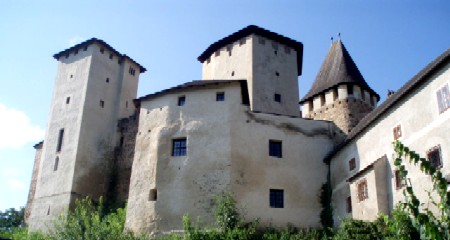 The
Lockenhaus castle was owned by many families throughout its long history. The building is a
fortress rather than a palace, with interior walls of unfinished mortar. Exploring the numerous
rooms is exciting. The Nádasdy family crypts, in the basement of the church, are a tourist
attraction especially due to a nasty countess who overutilized the torture chamber. The
Esterházy family bought the castle when the Nádasdy produced no heir. This later family, using
English terminology, would be called Kings and Queens of this region, maybe even for all of
Hungary. One of their early ancestors was appointed Holy Roman Emperor. The communists not only
seized their lands but imprisoned the male heir. The
Lockenhaus castle was owned by many families throughout its long history. The building is a
fortress rather than a palace, with interior walls of unfinished mortar. Exploring the numerous
rooms is exciting. The Nádasdy family crypts, in the basement of the church, are a tourist
attraction especially due to a nasty countess who overutilized the torture chamber. The
Esterházy family bought the castle when the Nádasdy produced no heir. This later family, using
English terminology, would be called Kings and Queens of this region, maybe even for all of
Hungary. One of their early ancestors was appointed Holy Roman Emperor. The communists not only
seized their lands but imprisoned the male heir.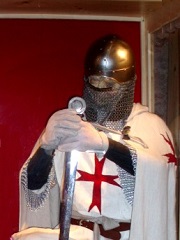 The
other bloody attraction of the castle is the ritual room where many Knights Templar
were slaughtered during the 1300’s. They were one of two organizations that protected crusaders
and Holy Land pilgrims. There is a small museum next to this room. The
other bloody attraction of the castle is the ritual room where many Knights Templar
were slaughtered during the 1300’s. They were one of two organizations that protected crusaders
and Holy Land pilgrims. There is a small museum next to this room.We stayed in a lovely hotel in Köszeg, Hungary. Some of my female ancestors came from there and also Sopron, both of which voted to stay Hungarian after WW-I. The cities are rich in history. Burgenländers from here should search both the Roman Catholic and Protestant church records because often the churches are side by side and individuals would change religions upon marriage, etc. Wandering these cities was a delight. Many buildings are ornate, the town squares huge, the churches beautiful and castles, quaint shops and friendly people abound. The food in Burgenland was the best I tasted throughout Europe. 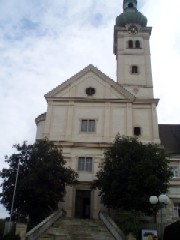 Our
hotel owner generously poured some free drinks and the menu exploded with bargain-priced gourmet
selections. Our
hotel owner generously poured some free drinks and the menu exploded with bargain-priced gourmet
selections. If I never was drawn here by my ancestors, I would consider this region one of the best kept secret vacation destinations. The forests, rolling hills, Roman ruins, fortresses, numerous hiking trails, hunting, fishing, Gothic and medieval architecture, embellished churches, large public squares, fountains, friendly people and very reasonable prices make these towns places to relax and explore. I read that a famine lasting several years was the cause of the turn-of-the-century emigration. My grandparents carried Burgenland in their hearts. Kathryn Augustin, granddaughter of Michael Augustin and Anna Schumeth, both born in Burgenland in 1869 and 1882. |
||||||||||||||||||||||||||||||||||||||||||||||||||||||||||||||||||||||||||||||||||||||||||||||||||||||||||||||||||||||||||||||||||||
3) THE AUSTRIAN WAR ARCHIVES IN VIENNA (KRIEGSARCHIV WIEN) Ed: The "Kriegsarchiv" in Vienna has been the subject of occasional discussion in this newsletter. In the text below, I adapt and update material published in 2007 by Christoph Tepperberg, Director of the Kriegsarchiv. In addition, I recently received a note from BB member John Eberhardt (from St. Louis, MO) wherein he pointed out the Rootsweb "Austro-Hungarian-Military-L" mailing list and archives as "a place where some knowledgeable folks will answer questions relating to Austro-Hungarian military issues." The list can be joined by sending an email to AUSTRO-HUNGARIAN-MILITARY-L-request@rootsweb.com with the single word 'subscribe' in the message subject and body. The archives can be found at http://archiver.rootsweb.ancestry.com/th/index/AUSTRO-HUNGARIAN-MILITARY/. Visiting the Archives 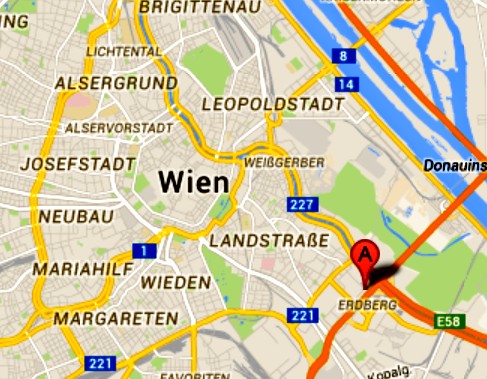 The
Archives is located in the “Central Archives Building” of the Austrian State Archives in
Erdberg in Vienna’s 3rd district, just opposite the station (“Erdberg”) of the U3 underground
line: Nottendorfer Gasse 2, A-1030 Vienna. The
Archives is located in the “Central Archives Building” of the Austrian State Archives in
Erdberg in Vienna’s 3rd district, just opposite the station (“Erdberg”) of the U3 underground
line: Nottendorfer Gasse 2, A-1030 Vienna.Before starting research in the common reading room of the Austrian State Archives, you have to buy a user ticket, as fees are required for using records in the reading room: for a five-day ticket, 10 Euros; for a 20-day ticket, 21 Euros; for a one-year ticket, 42 Euros. For further details, see the website of the Austrian State Archives: http://www.oesta.gv.at/site/4940/default.aspx Be warned that records can be used only in the reading room and that archival documents will be available for use not sooner than 24 hours after being ordered, so plan at least a two-day visit: one day to order materials, the second to use them! Only pencils (no ball-point or other pens) are allowed in the reading room. There is a copy machine in the reading room and photo copies, reader prints, microfilm copies, color copies, photo prints, and scans can also be ordered through the reading room desk for a charge. A printed inventory and finding aids concerning the various record groups of the Kriegsarchiv are available in the reading room. Initial information can be obtained at the reading room desk or from the archives’ directorate. You can also search the central database of the Austrian State Archives via the internet: (http://www.archivinformationssystem.at/). Written Inquiries Written inquiries are answered in due course by archives’ advisors. Because of personnel shortage, however, the archives’ staff is unable to undertake extended research. Payment is required for such research at a rate of 37 Euros per half-hour. Professional Researchers Acording to the Archives, if you wish to have research undertaken for you, "some private persons or institutions have in the past provided research services. While the archives cannot vouch for their reliability, so far, experiences have been quite satisfactory. Potential customers are to be aware, however, that genealogical research usually is quite time-consuming, and should clarify maximum expenses in advance!" Hungarian Military Archives The Hungarian Military Archives in Budapest (Hadtörténelmi Levéltár) is at Kapisztrán tér 2-4, H-1014 Budapest, with e-mail: him.leveltar@hm-him.hu, and is the main depository for personnel as well as other records for the Hungarian parts of the Monarchy. In addition the archive holds a collection of Austro-Hungarian military parish registers. (Website: http://www.hm-him.hu/hun/rlglap.php?rlgazon=4). Sources for Genealogical Research in the Other "Successor States" Under the peace treaties of 1919, archival records pertaining to areas outside today’s Austrian Republic had to remain in, or to be transferred to the "successor states" (Czecho-Slovakia, Hungary, Poland, Yugoslavia) as well as Italy and Romania for regions now belonging to these countries. Therefore, with few exceptions, personnel documents for soldiers from regions outside the present Austrian Republic are to be found in relevant archives in the “successor states,” although most of these files are considered lost. Czech Republic: The Czech Historical Military Archives in Prague (Vojenský Historický Archiv, Sokolovská 136, CZ-186 00 Praha 8 - Karlín; e-mail: zikesj1@army.cz; website: http://www.army.cz/acr/vuapraha/index.htm), now a department of the Vojenský Ustredny Archiv, hold service sheets for soldiers from Bohemia, Moravia, and Silesia, mainly for the years of birth: 1865-1886. Although the majority of documents for soldiers born between 1887 and 1900 were destroyed, some officers’ files and files of some important persons were preserved in Prague. See http://www.genea.cz/vojaci/vha.htm (most of the pre-1865 records are kept in the Vienna Kriegsarchiv). The VHA in Prague also holds a collection of Austro-Hungarian military parish registers. Italy: For the Trieste and Kuestenland (maritime) provinces as well as for parts of Carinthia and Carniola, personnel records are kept in the State Archives of Trieste (Archivio di Stato di Trieste, Via Lamarmora 17, I-34139 Trieste; website: http://archivi.beniculturali.it/ASTS; e-mail: asts@archivi.beniculturali.it). The Archives in Bozen/Bolzano (Archivio di Stato di Bolzano, Via Armando Diaz 8, I-39100 Bolzano); website: http://www.archivi.beniculturali.it/ASBZ/; e-mail: asbz@archivi.beniculturali.it) includes copies of personnel records for soldiers from the Trentino, and South Tyrol provinces. Poland: The Central Archives of Historical Records (Archiwum Glówne Akt Dawnych, ul. Dluga 7, PL-00-263 Warszawa; website: http://www.agad.prv.pl/; e-mail: sekretariat@agad.gov.pl), is the main deposit for church records from the East Galician areas (now Ukraine), and also has certain Austro-Hungarian military records, but do not have Austro-Hungarian military personnel records. However, the Central Military Archives in Warsaw (Centralne Archiwum Wojskowe, ul. Czerwonych Beretów bl. 124, PL 00-910 Warszawa-Rembertów; website: http://www.caw.wp.mil.pl/; e-mail: caw@wp.mil.pl) keeps personnel records for those soldiers who served in the Polish army after 1918. The majority of personnel records for soldiers from Galicia and parts of Silesia (today Western Ukraine and Southern Poland) was destroyed. Slovakia: The majority of the Austro-Hungarian personnel records, which were stored in the repository for military personnel files in Tyrnau (Trnava) respectively in the Slovak Historical Military Archives (Slovenský Vojenský Historický Archiv, Univerzitní námestie c. 2, P.O. Box 71, SK-917 00 Trnava; email: vha@centrum.sk), has been destroyed or handed over to the VHA in Prague. The SVHA in Trnava holds collections of Austro-Hungarian military parish registers and war graves documents, as well as the records of the military hospital for disabled persons in Trnava (Militaer-Invalidenhaus Tyrnau). Ukraine: The Central State Historical Archives of Ukraine in L’viv (Tsentral’nyi derzhavnyi istorychnyi arkhiv Ukrainy, pl. Soborna 3a, UA-79000 Lviv, Ukraine; website: http://www.archives.gov.ua/Eng/; e-mail: archives@cl.lv.ukrtel.net) has some Austrian personnel records in its collection No. 780. Slovenia, Croatia, Serbia, Bosnia-Herzegovina, and Romania: The majority of personnel records for soldiers from Lower Styria and Carniola (now Republic of Slovenia), Croatia, and Bosnia-Herzegovina, as well as the now Romanian parts of Hungary (Siebenbuergen/Transylvania) were evidently destroyed or lost. The Croatian State Archives (Hrvatski Državni Arhiv, Marulicev trg 21, HR-10000 Zagreb; website: http://zagreb.arhiv.hr/; e-mail: hda@arhiv.hr) holds a collection of Austro-Hungarian military parish registers. |
||||||||||||||||||||||||||||||||||||||||||||||||||||||||||||||||||||||||||||||||||||||||||||||||||||||||||||||||||||||||||||||||||||
4) MEMOIR OF RAYMOND BUBICK (Part 2) Ed: In the November 2014 Newsletter, I published Part 1 of the "Memoir of Raymond Bubick." As you may recall, BB member Kevin Krizman had written to report Ray's death in October and to share Ray's unfinished memoir. Part 1 covered the first section of Ray's memoir, the "Forward" and "Ancestry" sections. This month, we conclude with the "Growing Up" section. MEMOIR OF RAYMOND BUBICK: GROWING UP 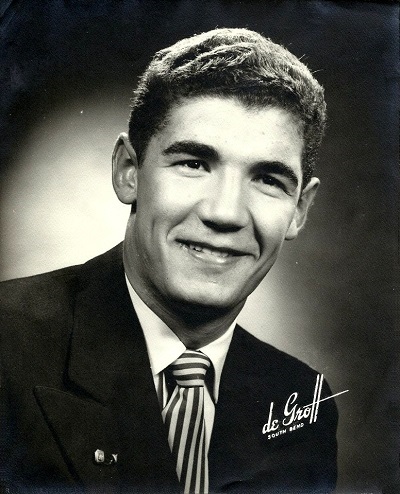 I
was born on January 5, 1933, at 2026 S. Kendall Street, South Bend, Indiana, at the northeast
corner of Kendall and Donald Streets. My parents could not afford a hospital or a doctor, as I
was born in the midst of the Great Depression. So I was brought into the world by a mid-wife. My
father had been working at the Studebaker factory but had been out of work for over a
year. They got by on the meager earnings my mother made from cleaning homes and being a part
time maid. I
was born on January 5, 1933, at 2026 S. Kendall Street, South Bend, Indiana, at the northeast
corner of Kendall and Donald Streets. My parents could not afford a hospital or a doctor, as I
was born in the midst of the Great Depression. So I was brought into the world by a mid-wife. My
father had been working at the Studebaker factory but had been out of work for over a
year. They got by on the meager earnings my mother made from cleaning homes and being a part
time maid.We lived on S. Kendall Street for the first three years of my life. It was a small enclave of immigrants with similar backgrounds as my parents. This type of living was convenient for immigrants, as it provided them with a common bond of friendship and helpfulness. My memory of that home is vague, but I do remember the cinder street. Actually it was probably a mixture of cinder (which is a slag from a metal furnace, or coal) and gravel, but I do remember it being very black. I remember us not having a refrigerator. We had one of those iceboxes, which people pay all kinds of money to own now. One had to get a block of ice and put it in the top compartment of the icebox. This in turn kept the food stored in the lower portion of the icebox fairly cool. The block of ice would last for two days or so, and was replenished by the "Ice Man" who made home deliveries. I remember having my mother wash the many wounds I received from falling in the cinder street. I would always be black from the cinders and have tiny pieces of cinder embedded in my knees, elbows or hands. The only pal I recall having at the time was Stevey Leopold. One day Stevey and I decided to go for a long tricycle ride. I remember having a light green or lime colored tricycle. My mother claims we were trying to run away but I have no recollection of that. I do remember being several blocks from home, and being taken home in a small panel truck. My parents bought their home at 1850 E. Bowman Street in 1936. I remember seeing the deed to the house in a trip I made to South Bend in 1993. They paid $2,000 for the house, putting $600 down. Many people lost their homes during the Depression, and my parents were able to buy that home at a very reasonable price due to it being repossessed by a bank. 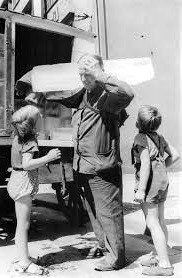 Our
home on Bowman also had an icebox, and it wasn't for several years thereafter that my parents
could afford a refrigerator. I remember the Iceman coming down the cinder-strewn street in a
horse drawn wagon. Whenever he reached our neighborhood, a trail of kids would follow him,
begging him for his daily ration of ice chips. On a hot summer day, he would chip off a few
pieces of ice and throw it to us kids. That ice tasted as good as any ice cream I ever ate. The
wagon in which the ice was drawn contained a huge amount of ice, insulated somewhat with straw
and canvas tarpaulins. I don't know how much of the ice was lost to melting on a hot summer day
but I suppose it was considerable. The ice had serration's every foot or so along the edges of
the ice. The Iceman would use his ice pick to measure the size of block to be taken to his next
customer. He wore a large leather apron and a padded leather pad over one of his shoulders.
After he "ice picked" the proper size block, he grabbed it with a pair of ice tongs, flung the
block on the padded shoulder and delivered it to the customer's icebox! In my early years,
icehouses that made ice were profusely located throughout every city, as most people didn't have
refrigerators. Our
home on Bowman also had an icebox, and it wasn't for several years thereafter that my parents
could afford a refrigerator. I remember the Iceman coming down the cinder-strewn street in a
horse drawn wagon. Whenever he reached our neighborhood, a trail of kids would follow him,
begging him for his daily ration of ice chips. On a hot summer day, he would chip off a few
pieces of ice and throw it to us kids. That ice tasted as good as any ice cream I ever ate. The
wagon in which the ice was drawn contained a huge amount of ice, insulated somewhat with straw
and canvas tarpaulins. I don't know how much of the ice was lost to melting on a hot summer day
but I suppose it was considerable. The ice had serration's every foot or so along the edges of
the ice. The Iceman would use his ice pick to measure the size of block to be taken to his next
customer. He wore a large leather apron and a padded leather pad over one of his shoulders.
After he "ice picked" the proper size block, he grabbed it with a pair of ice tongs, flung the
block on the padded shoulder and delivered it to the customer's icebox! In my early years,
icehouses that made ice were profusely located throughout every city, as most people didn't have
refrigerators.Another home delivery service during my youth was the service provided by the ubiquitous Coal Man. Most homes back in the '30s and '40s were heated by coal furnaces. The furnaces, of course, required coal, and the Coal Man would deliver coal to each home. I remember him always being coated with coal soot and he looked like the proverbial chimney sweep who had just finished "sweeping" a chimney.  Hanging
from the side of the bed of his truck was a long "coal chute" and his huge coal shovel. Each
home in those days had a coal bin located in the basement, in which the coal would be stored,
and usually an iron window providing access to the coal bin. The Coal Man would back up his
truck in the proximity of the coal door, attach the coal chute to his truck and insert the other
end into the coal door. Then he would shovel the coal from the truck bed onto the coal chute
that cascaded the coal into the home's coal bin. I remember my parent's would get about two such
deliveries of coal every winter and, as best as can recall, each one-ton delivery cost about
$25. Hanging
from the side of the bed of his truck was a long "coal chute" and his huge coal shovel. Each
home in those days had a coal bin located in the basement, in which the coal would be stored,
and usually an iron window providing access to the coal bin. The Coal Man would back up his
truck in the proximity of the coal door, attach the coal chute to his truck and insert the other
end into the coal door. Then he would shovel the coal from the truck bed onto the coal chute
that cascaded the coal into the home's coal bin. I remember my parent's would get about two such
deliveries of coal every winter and, as best as can recall, each one-ton delivery cost about
$25.The coal furnaces had no blowers. They just provided heat by convection from the furnace to pipes going to each room in the house. Each morning, my dad would rise, go down in the basement, chop some kindling wood, and go through his daily ritual of starting a fire in the furnace. The coal slag would drop into a lower compartment of the furnace and, when adequately filled, my dad would shovel the slag out of the furnace into a box. During the day, my mother would re-stock the burning furnace with a couple of shovels of coal. In the evening, my Dad would put one last shovel into the furnace. By morning, the fire would be out and my father went through the whole fire starting ritual again. People who had more money than my parents had a coal conveyor device with a hopper on it that would deposit coal periodically throughout the day via the conveyor belt. As I got older, I would shovel the slag (or ashes) from the furnace to the box. It was my exclusive responsibility to get rid of the coal ashes and slag, so I was literally one who "hauled ashes." The way I disposed of the ashes [the EPA would have a stroke nowadays] was to take my box of ashes, put it on my little red sled and haul them about three blocks and dump them into to an empty open field. No one ever asked questions, as many people did the same thing. I don't think my brother ever had the privilege of "hauling ashes" because we finally got a natural gas furnace installed in the mid '40s and, if I had to guess, I would say about 1946 or so. In 1938, my Dad was working for the Sterling Pump Corporation as a machinist and sometime tool and die maker. Sterling decided to move to Hamilton, Ohio, so my parents decided to follow them. After just coming out of a long period of unemployment, my Dad didn't want to be out of a job in the still depressed job market in South Bend. So Dad, Mom, my sister and I headed for southern Ohio. We moved to Kahn Avenue in Hamilton. I was going to kindergarten at Lincoln School in South Bend before our move, so my parents tried to get me into kindergarten in Hamilton. 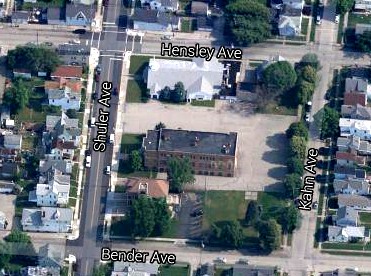 However,
I couldn't get into one, so I was put into the first grade, and hence finished both kindergarten
and first grade in one school year. The school I went to was St. Veronicas Catholic Grade
School, which was a short two blocks from our residence on Kahn Avenue. However,
I couldn't get into one, so I was put into the first grade, and hence finished both kindergarten
and first grade in one school year. The school I went to was St. Veronicas Catholic Grade
School, which was a short two blocks from our residence on Kahn Avenue.We weren't on Kahn Avenue very long, however. We moved to 930 S. 11th Street, and that is where we stayed until we moved back to South Bend in 1942. It was during this time that I remember becoming very close with my sister Lillian [Ed: Lillian was mother to Kevin Krizman, who shared Ray's memoir with us]. In my view, she was an angel. Shortly after I was born, she had a severe bout of strep throat, which ultimately lead to Rheumatic Fever. The Rheumatic Fever permanently damaged a valve to her heart, and she was forever more hindered with this defect. This ultimately led to her premature death in 1968 to heart failure. She was only 42 when she died, and she died as she had lived, an angel. She died shortly after the delivery of her seventh child. She had been advised by her doctors not to have any children, let alone seven. But, she had complete faith in her God and her religion, and always said she would take her chances with the Lord. In retrospect, she left a legacy of seven lovely children, and no one can ever accuse her of sacrificing her life on a whim. I think I was in the first grade when my sister thought it was her duty to inform me of the birds and the bees. I didn't know the anatomical differences then and thought the story of the stork bringing babies as more charming! As it turned out, that was the only 'official' sex instruction I ever received. Everything else I learned, I learned on the streets, as my mother and dad never broached the subject with me. 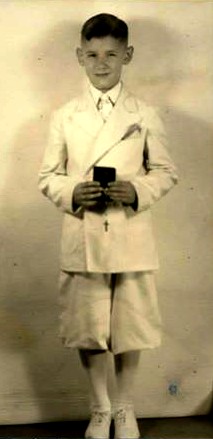 Life
was mostly pleasant for me in Hamilton. I was seven years old when, on May 5, 1940, I made both
my first communion and confirmation in the Catholic Church. My mother thought I was destined for
sainthood, as her whole life revolved around the church. Somewhere in the archives of my
menagerie of pictures are a few of me in my first communion garb. Life
was mostly pleasant for me in Hamilton. I was seven years old when, on May 5, 1940, I made both
my first communion and confirmation in the Catholic Church. My mother thought I was destined for
sainthood, as her whole life revolved around the church. Somewhere in the archives of my
menagerie of pictures are a few of me in my first communion garb.When we lived on 11th Street, I shared a bed with my sister for a while and I remember on weekends, when we didn't have to go to school, we would lie in bed and play word games. I remember having an awful nightmare once—it was one of those unforgettable dreams that we all have from time to time. All I remember about the dream was that a huge lion was roaring down the street in front of our home and Lillian comforting me in our mutual bed. I don't remember ever having a fight or dispute with Lill. Since she was seven years older than me, I suppose that made some difference. It wasn't long, though, until my parents decided that it would be best that we had separate beds. So, sometime in 1940 or '41 they bought the bunk beds that my mother had in her home in South Bend. I remember those beds because I specifically remember December 7, 1941, when the Japanese bombed Pearl Harbor, that I laid in my top bunk bed being frightened about the possibility of our home being bombed. My parents reassured me that we lived too far from the Japanese for them to bomb us. Shortly thereafter, on Christmas Day of 1941, my brother was born. I remember my mother saying that another little angel had been born on Christmas day. [Several years later, of course, I also remember her saying, because of the mischievous meanderings of my brother, that he was a little devil that was born on Christmas]. It was during this period while living in Hamilton, that my mother decided to become a Beautician. She was frightened about going back to school, but she wanted to improve her lot, and always claimed to have a premonition of needing to support herself without depending upon my father. [As is turned out, she was certainly correct, as in 1948 my father came down with tuberculosis, was hospitalized and, until his death in 1955 due to lung cancer, only worked for a few months in support of our family.] My mother never went past the eighth grade in her formal education while growing up in Austria, so this compounded her feeling of inadequacy. 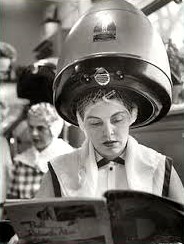 When
she first started Beautician schooling, she told the school that she graduated from high school,
knowing there was no way anyone could verify that. She was discouraged at the start, felt very
inadequate, and didn't have much belief in herself. She was very discouraged, not only because
of the language problem but she felt she was not up to going to school and raising a family as
well. When
she first started Beautician schooling, she told the school that she graduated from high school,
knowing there was no way anyone could verify that. She was discouraged at the start, felt very
inadequate, and didn't have much belief in herself. She was very discouraged, not only because
of the language problem but she felt she was not up to going to school and raising a family as
well.She was about to quit, but her instructors told her, "Margaret, you should not quit, you have a rare talent of learning quickly, you have the dedication it takes to improve yourself, and have the maturity which the other women do not have!" With this encouragement, she not only finished, but graduated as the top student in her class. My mother always claimed that God had directed her to this goal. Maybe she was right, because, during the years my dad was sick, she supported our family, and was able to do so without leaving our home, as she had her beauty shop set up in the front of our home on Bowman Street. World War II was an education for me. At the start of the war I was just 7 years old and didn't understand the complexities and severity of its impact on our nation. But, we found out rapidly. Everything was rationed, and most of the production capability of our country went into what was called the War Effort. From 1942 to the end of the war in 1945, no consumer automobiles were made. All the auto manufacturers produced tanks, airplanes, and trucks and vehicles for the military. Our family received ration books for each member of the family. Inside the ration books were coupons, which we used to buy just about everything. For example, when we went to the grocery store, a can of green beans would cost 10 cents, but we also had to surrender 10-15 ration coupons for that can of beans. Gasoline was rationed. My dad had a big “A” sticker on his car, which meant that he had the lowest priority for buying gasoline. I think he could buy something on the order of 10 gallons of gas a week. Car parts were scarce, tires were even more scarce. I remember the first Christmas after the war was a momentous one for me because I finally was able to get a basketball for Christmas, as they were not made during the war. But the country was truly motivated and was completely united behind the War Effort. There was no protest of the war or derisiveness among the populace. Everyone cheerfully made the sacrifice to win the war. Our nation has not experienced that since. 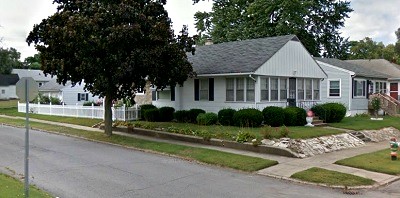 In
1942, my parents decided to move back to South Bend. I don't remember the reason, but I suppose
they missed all their friends and had it in the back of their minds to eventually return to
South Bend, since they never relinquished the house on Bowman Street; they had it leased out
during our years in Ohio. In
1942, my parents decided to move back to South Bend. I don't remember the reason, but I suppose
they missed all their friends and had it in the back of their minds to eventually return to
South Bend, since they never relinquished the house on Bowman Street; they had it leased out
during our years in Ohio.One of the first things they did upon return was to convert the old front porch of the house to my mother's beauty parlor. From that day forward she was in business and worked on women's hair until she was 85 years old. They enrolled me into St. Matthew's Parochial School in South Bend. I was in the fourth grade and finished my grade school education there until eighth grade graduation in 1946. I remember being very shy on my first days at St. Matthew's; the boys had to pry me out of my shell. I don't remember ever being so shy. Among my grade school pals who remained friends of mine over the years, was Len Smorin. Len and I were friends through high school and college days, although we went to different colleges. My first cousin Arlene Fleischaker, lived only one block from our home and, since we were the same age and went to the same school, we did many things together. She was almost like a sister to me. She reminded me in our later years, however, that as soon as my male friends would come near, I would abandon her and play with them instead. My parents became socially active in the St. Anthony's Sick Benefit Society, which consisted primarily of their Slavic friends who banded together to form a group who, through their membership fees, would pay sick benefits to its members who couldn't work and needed money to help support their families. However, St. Anthony's was also a social gathering place for all the Slovaks to have dances, weddings (my sister Lillian had her reception there in 1948), card games and bowling activities. In addition to the regular bowling lanes, I still remember the old fashioned bowling lane they had. It was very similar to the "bocce-bowling" in which many people of Italian descent participated. It was about 30-40 percent longer than the regular lanes, had no gutters, nine pins instead of ten, and 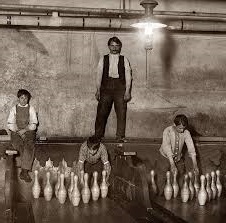 the
ball was about 1/3 the size of a regular bowling ball and had no finger holes. I remember, as a
young lad, setting pins for my Dad and his cronies. Back in those days, there weren’t the
automatic pinsetters they have today. Usually a young lad would clear the pins resulting from
the first ball, return the ball down a chute, and reset the pins after the bowler was done with
his turn. This procedure was done on regular bowling lanes as well; in fact, my buddy Len Smorin
earned all his spending money during our grade school years setting pins, as it was
called. the
ball was about 1/3 the size of a regular bowling ball and had no finger holes. I remember, as a
young lad, setting pins for my Dad and his cronies. Back in those days, there weren’t the
automatic pinsetters they have today. Usually a young lad would clear the pins resulting from
the first ball, return the ball down a chute, and reset the pins after the bowler was done with
his turn. This procedure was done on regular bowling lanes as well; in fact, my buddy Len Smorin
earned all his spending money during our grade school years setting pins, as it was
called.St. Anthony's, being a private club, didn't have to comply with the normal liquor laws of the State of Indiana. What this, in effect, meant was that they could serve booze on Sundays. My Dad would often take me to the "Club," as he referred to St. Anthony's, on Sundays to have a beer or two with his friends, much to the consternation of my mother. My mother hated my father going to the "Club," as she knew he would have a few "brewskis." She disdained the thought of my father drinking and would often not accompany him to the "Club," so he would go by himself. They often got into arguments over this and it affected me as a child. When my Dad would take me to the "Club," I learned how to shoot pool. Also, I would watch my Dad and his cronies playing a card game that I've never seen since. They played with cards that came from the Old Country, and would drink beer and commiserate among themselves about politics and all other subjects. They would talk in Croatian and have a good ole time among themselves. I also still remember the long bar in the "Club"—it actually had brass spittoons placed strategically along the floor of the bar, along with a brass foot-rails, none of which one would see in today's saloons. And yes, a spittoon is used for what it sounds like, to spit in! Back in those days, most men either smoked or chewed tobacco and just about all saloons or bars had spittoons into which one could expectorate his tobacco juice. After a short stop at the "Club," my Dad often took me to visit one his pals, Charlie Derdak. Ole Charlie was a distant uncle of mine. He had three children, John, Vic and Mary, who were second cousins of mine. Anyway uncle Charlie would make his own wine and I was always offered a glass of wine during our visits. My mother never came, of course, because wine or beer was always served at uncle Charlie's. I remember ole uncle Charlie used to smoke a pipe, and he always used a catsup bottle top with holes poked in it that he placed on the top of the bowl of the pipe. I've never seen anything like that since. 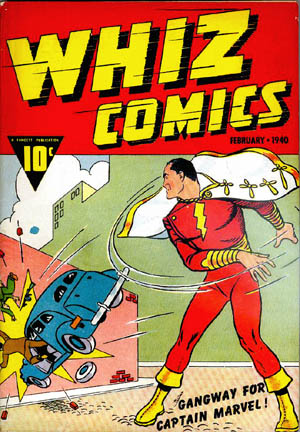 Saturday
nights were a special treat for me while growing up. My mother would give me 25 cents. I would
go to the local store and get a six-pack bottles of my favorite soft drink, Pepsi Cola. If you
returned the empty bottles, you could get six refilled bottles for 25 cents. Once a month, when
the new Capt. Marvel comic books came out, my mother would give me an extra 10 cents to buy a
Capt. Marvel comic book. He was my favorite. When young comic hero Billy (I’ve forgotten his
last name) would utter the magic word SHAZAM, he would instantly turn into Capt. Marvel,
fighter of evil and crime in the world! I preferred Capt. Marvel to Superman and Batman. Saturday
nights were a special treat for me while growing up. My mother would give me 25 cents. I would
go to the local store and get a six-pack bottles of my favorite soft drink, Pepsi Cola. If you
returned the empty bottles, you could get six refilled bottles for 25 cents. Once a month, when
the new Capt. Marvel comic books came out, my mother would give me an extra 10 cents to buy a
Capt. Marvel comic book. He was my favorite. When young comic hero Billy (I’ve forgotten his
last name) would utter the magic word SHAZAM, he would instantly turn into Capt. Marvel,
fighter of evil and crime in the world! I preferred Capt. Marvel to Superman and Batman.One of the aspects of my growing up was the fiscal habit of fending for myself. My parents never gave me an allowance; the old world thinking was such that children had to make contributions to the family. Hence, when I started to get a real job, I would save a portion of the money I made during the summer months. For example, I started working fulltime summers in 1948 when I was 15 years old. I remember my old friend Gene Cserpes getting me a job that summer with Whitcomb and Keller, a construction company building pre-fabricated homes. I think I made 60 cents an hour back in those days for very backbreaking work (although in the summer of 42, I worked for two days as a weed puller in the mint fields outside of South Bend, where I made the outrageous wage of $1.00 per day). Since 1948 was the year my father got sick, I knew I wouldn’t get any spending money during the school year. Since I wanted to participate in athletics, that meant I couldn't work during the school year, so whatever money I made during the summer is what I used for my spending money. So what I did for the nine months of the school year was to get nine envelopes and divide my savings of the summer by nine and put that in the envelopes. For example, during a typical summer, I would save between $300 to $360. Hence, I would put between $30-$40 dollars in each envelope and would put the nine envelopes in my drawer. Never would I go into a future month to fund any expenses I had in a current month. I've told this story to some of my kids and they almost didn't believe me, but it is true! Ed: Here ends the portion of the memoir that Kevin shared. I'm sure that many of our ancestors have similar stories of family connections in the old country and of both the trials and joys of growing up as first-generation Americans. I thank Kevin for sharing it and invite you readers with similar memoirs to consider sharing them with the BB readership. |
||||||||||||||||||||||||||||||||||||||||||||||||||||||||||||||||||||||||||||||||||||||||||||||||||||||||||||||||||||||||||||||||||||
5) USING PATTERNS TO FIND AN UNKNOWN (by Margaret Kaiser) Margaret writes: This is part of an article I wrote for our county genealogical society quarterly: This quarter, I thought I’d share a recent search query AND show how it was successfully accomplished. In an Austria-Hungary group where I participate, a member requested assistance researching his ZWIKL family roots. The family was found on the 1930 and 1940 US censuses in Northampton Co, PA, where many Burgenlanders settled. But the family was not found in the 1910 or 1920 censuses. What’s in a name, and where to start? First, list what is known. In 1940, a Frank ZWICKL, age 67, wife Theresia, and children lived in Northampton, PA. In 1930, a Frank ZWICKL, age 57, wife Theresia, and children lived in Northampton, PA. And, in the 1918 WW-I cards, a Frank ZWIKL, born April 1873, alien, resided in Northampton, PA. Second, analyze and consider possibilities. Was the name miswritten on the 1910 and 1920 censuses? Very possible. Using only what was consistently known, and avoiding the surname altogether, I searched on first name = Frank, born = 1873, residence = Northampton, with spouse = Theresia — and got results. In 1920, the family was listed as ZWIGGLE/ZWIZZLE. In 1910, the surname is written as SVGIL. Subsequently, the surname on his PA death certificate was written correctly but was indexed by Ancestry.com as ZUIKL, and this indexing error also appears in the PA death certificate database (a sibling also appears on the PA death index as ZUICKLE). Despite the spelling differences, all the family members’ ages and relationships fit exactly as they should. By using what was known, I was able to find the patterns that led me to the unknown. A tip that I hope everyone will try sometime! Ed. note: Margaret does not explicitly say so but she generally does her searches using Ancestry.com (library edition, I expect). However, the FamilySearch.org search tool also allows searches like this and I often succesfully find people by these techniques when a "regular" surname search fails. If you haven't tried this on your missing ancestors, you should. Another tip when using FamilySearch.org is to use wildcard characters ? and *. ? replaces a single character while * replaces one or more; these characters can be used in combination and/or more than once in a search string. Thus ?wickl might find Zwickl or Swickl, whereas *ickl might find Zwickl or Svickl. I'm sure you can think up other variations, so give it a try! |
||||||||||||||||||||||||||||||||||||||||||||||||||||||||||||||||||||||||||||||||||||||||||||||||||||||||||||||||||||||||||||||||||||
6) HISTORICAL BB NEWSLETTER ARTICLES Editor: This is part of our series designed to recycle interesting articles from the BB Newsletters of 10 years ago. We do this, of course, because we continue to attract new members to the BB, who likely have not read these old articles (they are in our Archive section) and because the articles are simply worth reprinting again (as some of us older members may have forgotten their content!). I chose the article for this month because it covers a Lutheran parish, something we generally know less about because the records were not always microfilmed. This one also touches on the Reformation and Counter-Reformation, as well as a bit about Lutheran emigration into Burgenland (a topic dear to Gerry's heart). Enjoy! THE BURGENLAND BUNCH NEWS No. 136A January 31, 2005 NEUHAUS AM KLAUSENBACH - REVIEW TRANSLATION OF VILLAGE HISTORY ED (Gerry) Note: Tom Grennes sent me a copy of this history some time ago, my reply follows. What I've done, Tom, is go through the history page by page, noting the important points, particularly if your family names appear. A complete translation is too much to take on, especially since I am not that proficient in German. While I have a working knowledge, certain of the archaic nuances and syntax may not be 100% correct - bear with me. As you can surmise, most of this history deals with the church and its congregations in the villages mentioned. Of major interest is the fact that mention is made of the movement of Lutheran families from Styria, just to the west of today's Burgenland. I strongly believe we can assume all of our Germanic Lutheran families (as well as some of the RC) migrated to southern Burgenland to the district of Jennersdorf (it was then the district of Szt. Gotthard, Hungary) sometime after the start of the Counter-Reformation in the latter half of the 1600's. This is not the first reference to such movement that I have seen - it appears in histories of Rudersdorf and Eltendorf as well. I wish we could find a list of those families. You'll notice that your family names are scattered over various villages. Unless you can link them with records, be cautious in claiming all of them. Some of these families had large branches. As an example, I can't establish a link to the Bergholds in Muhlgraben although one even showed up as godparent to a Henilgenkreuz Berghold - obviously related in some manner. From the beginning of the Counter-Reformation until the passing of the Edict of Toleration, we had about a hundred-year period when our Lutheran families had no church and no possibility of Protestant sacraments - I know they used the existing RC churches for that purpose as I have church records of RC parishes which baptize and marry Lutherans who are so identified. Thus the early RC church records will also contain records of Lutheran families. Starting about 1780 this stops and, in the Heiligenkreuz church, I find few Lutheran notations after that time. Look to the RC churches for records prior to that date. Now for the translation scan: 200TH YEAR OF THE EVANGELISCHE CHURCH (PARISH) IN NEUHAUS AM KLAUSENBACH (History Of A Community) Greetings from Superintendent Gertrude Knoll Greetings from Parish Priest of Jennersdorf - "where two or three gather in my name, there am I also" Greetings from Josef Hotwagner, Village Priest (and Dechant) of Neuhaus - "tolerance among men" Forward by Barbara Schildböck - explaining the worthy contents of the chronik - on a Sunday in 1994 in the first year of ordination, Neuhaus Kantor (Cantor, orgainist, choir master) Karl RUCK portrayed his masterful skill on the organ. - the reminiscences of Pfarrer Alexander Gibiser (now retired in Eltendorf) - the singing prowess of Daniela and Erhard SCHWARZL - the historical part rendered by Gustav JUD etc. etc. Page 11 - Historical Overview (1665 view of Castle Güssing) The history and story of the Lutheran community of Neuhaus am Klausenbach is bound to the history of Castle Neuhaus (now 13th century ruins). The Lutherans stem from the middle of the 16th century, when many of the inhabitants were Lutheran. The Batthyány family in 1569 made the Lutheran faith official. The house of Batthyány had great influence north of the Raab (to present times) and during the time of the Reformation and the Turkish wars. The Herrschaft of Neuhaus encompassed the region south of the Raab and for a long time was under the rule of the noble Szechy family. One heir (of this family) was Margarete Salm. During her and her daughter Magdalena's lifetime, Neuhaus became Lutheran in 1555. The castle became a sanctuary for Protestants from Austria; about 1600, many Styrian Protestants came here. They had their children baptized here. Schoolteachers (Lutheran) were also available. Parish beginnings in this region before and around 1600 are not authenticated and we must look to the first half of the 1600's to find their beginnings. It is known that, in the year 1597, Magdalena had the Graz superintendent Dr. William Zimmermann visit in order to found a school. 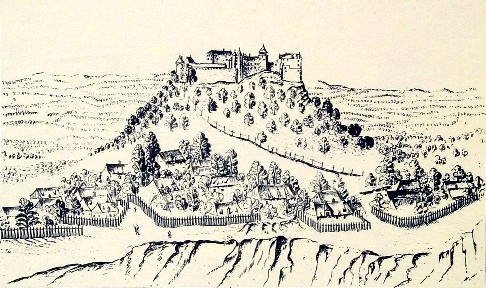 Page
12 - Historical Overview (continues) - old descriptive view of Neuhaus and castle Page
12 - Historical Overview (continues) - old descriptive view of Neuhaus and castleIn 1599, the Graz Pfarrer Osius came here. (Pfarrer is used as descriptive title for RC priest as well as Lutheran Pastors - I won't change it to English). In 1567, Magdalena married Ladislaus Poppel-Lobkowitz but was soon widowed. Magdalena and her daughter Eva were both Lutherans. In 1607, Eva married Count Franz Batthyány II. Thus Neuhaus and the strong Batthyány family were united and the domain became strongly Lutheran. In about 1595, the Lutheran and Hungarian Reformed (Calvinist) churches separated. Franz II and later his son Adam were Reformed at this time. As long as they were involved, the Reformed was the senior church through about 1630. Eva lived in Güssing (in the castle obviously) when her husband died. Her son Adam went to Vienna. The noble houses in western Hungary began to again turn Catholic (about this time the Counter-Reformation was in full swing with the Pope sending many Jesuit priests to Austria and elsewhere to again convert the nobility). Eisenstadt converted in 1622 as well as Forchtenstein and, in 1633, the entire Nadasdy holdings. Adam converted in 1630. For three years he tried to get his mother to convert. (This section gets confusing - it looks like he gave Neuhaus back to her, giving up Batthyány claims - perhaps he allowed Neuhaus Lutherans to stay Lutheran as long as she was alive.) 1634 was an historic year for Neuhaus - it was the 160th anniversary of the building of the church. However, in this year Adam gave all Lutheran pastors, preachers and teachers 15 days to leave his domain and all Lutherans were forced to convert. In the district of Jennersdorf the congregations of the parishes of Deutsch Kaltenbrunn, Königsdorf, Zahling, Heiligenkreuz and Neuhaus had to convert. NOTE: Your covering letter says your grandmother owned one of the Herrschaft houses as shown on page 12. Page 12 mentions "das Haus Nadasdy" - this translates to "the noble house Nadasdy" - it doesn't refer to the "vulgo house Nadasdy" - now in each village there were houses owned by the noble Herrschaft. These houses were not lived in by them but were rented or provided to workers on their estates. Sometimes they were inhabited by village clerks or "Richter." Quite possible that your grandmother owned such a house as many were sold during the distribution of noble property after 1848. See Klaus Gerger's house lists available from the homepage for houses that were owned by the nobility after that time. As an example, my cousins (Berghold-Schabhüttl) in Rudersdorf now operate a Gasthaus that was once the Batthyány coach stop. Page 13 - Historical Overview (continues) Mentions the lack of places for the sacraments following the dissolution of the Lutheran churches. The authorities then allowed the Lutherans to erect prayer houses but even then the lack of pastors precluded baptisms etc. Eventually the RC churches were instructed to provide the sacraments but to show the faith in the records (from this time on the records show RC or Rk or Augs. Conf. for each record). Lutherans had a bad time in the latter 1600's. The Hungarian Landtag or parliament, meeting in Sopron, attempted to provide some relief. Page 14 - Historical Overview (continues) Table showing population then and now, by faith. Explains rules governing Lutheran prayer houses, etc. Page 15 - Historical Overview (continues) Explains the Tolerance Patent of 1781 issued by Josef II (Austria), which established Lutheran rights to again build churches. Page 16 - Historical Overview (continues) 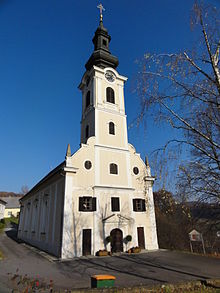 In
1783, Lutheran church buildings were started in Eltendorf, Neuhaus, Tauka, Minihof-Liebau,
Windisch Minihof, Mühlgraben and Krottendorf. Wooden prayer houses were quickly established.
First Eltendorf pastor was Daniel Klement. For nine years, the Neuhaus Lutherans went to church
in Eltendorf (another place to look for records). In 1790-91, the rights of Protestants were
again debated by the Landtag at Pressburg. In 1792, the Neuhaus Lutherans had enough members
(1018) to have their own church. Count Maximilian Batthyány provided material and assistance for
a church to be built by the Schmidt-Garden (property of Hans Paar). By Easter of 1793, enough
stone was brought to the site to complete the building. Nov. 30, 1794, a Tolerance prayer house
was erected. Date can still be seen on the stone of the church tower. In
1783, Lutheran church buildings were started in Eltendorf, Neuhaus, Tauka, Minihof-Liebau,
Windisch Minihof, Mühlgraben and Krottendorf. Wooden prayer houses were quickly established.
First Eltendorf pastor was Daniel Klement. For nine years, the Neuhaus Lutherans went to church
in Eltendorf (another place to look for records). In 1790-91, the rights of Protestants were
again debated by the Landtag at Pressburg. In 1792, the Neuhaus Lutherans had enough members
(1018) to have their own church. Count Maximilian Batthyány provided material and assistance for
a church to be built by the Schmidt-Garden (property of Hans Paar). By Easter of 1793, enough
stone was brought to the site to complete the building. Nov. 30, 1794, a Tolerance prayer house
was erected. Date can still be seen on the stone of the church tower.Page 17 - Historical Overview (continues) Story of the church bells with table showing what happened to the 9 bells used from 1801 to the present. Page 18 - Historical Overview (continues) In 1815, the cemetery by Minihof-Liebau was started through the efforts of Pastor Samuel Klement. 1839-1869, Neuhaus church was enlarged. 1865 saw the erection of the Pastor's house. 1870, a school building. 1892, more renovations to the church. Note: the Pastor was provided with land and had to do some farming as part of his living. 1894, 100th Jubilie saw a bell tower added to the church erected by the master smith Georg Dornfried of Windisch Minihof. The bell ringer for many years was FRANZ JUD from Mühlgraben house no. 91 (vulgo Bartlschneider) often with help from Wilhelm Mikschofsky of no. 49 Neuhaus. GEORG JUD from Mühlgraben was Kurator. Many donations for improvements including 100 Kronen from Emperor Franz Josef. Page 19 - Historical Overview (continues) Deals with the transportation of the baptismal font from Berlin to Jennersdorf. Even with a war on, the 400 year anniversary (1517-1917) was celebrated. Bronze tablet shown. Page 20 - Historical Overview (continues) 1918-1921, Organ installed - begins explanation of the Anschluss joining the area to Austria. Page 21 - Historical Overview (continues) The Lutheran Landwirt (farmer owning land) and Maurer (builder) GUSTAV SCHWARZL (1890-1984) from Neuhaus (vulgo Laourwe) were active in the Anschluss working with the prime mover Karl Wollinger. Schwarzl was part of the "free corps" or military group supporting the Anschluss. Was granted a medal by the Burgenland government in 1962 for his service. Picture is shown. Also mentions JOHANN SCHWARZL of Krottendorf no. 30 as Kurator throughout the war years (WW-II). Page 22 - Historical Overview (continues) More on the war years and Nazi period. Page 23 - Historical Overview (continues) Ditto but KARL RUCK of Minihof-Liebau no. 36 mentioned as being part of a group created to serve the organ during the war years. Ruck served from 1941. Page 24 - Historical Overview (continues) Explains the efforts of the Nazi Party to curb church activities and importance. In the Fall of 1940, FRANZ RUCK (Mühlgraben 47), MICHEL RUCK (Minihof-Liebau 5) and others were directed by the Nazi party to stop their church activities. By war's-end, over 37 Lutherans had been removed from the church (I don't know if this means jailed or forced to quit the church). Page 25 - Historical Overview (continues) WW-II in the district, including a picture of the monument explaining the burial of 92 Jews and concentration camp workers at Krottendorf (mass grave?). They were brought there to work on defensive border sites. Page 26-27 - Historical Overview (continues) More WW-II but on page 27 Herr RUCK (which one - must be Karl?) returned from the war and took up serving the organ. Return of the church bell. Pages 29-31 - Historical Overview (continues) Post-war years including picture of Kantor Karl (?) RUCK Pages 32-33 - Historical Overview (ends) More on post-war years to present. No names other than pastors mentioned. Next Sections, through page 44, concern daughter-sister congregations and preachers and pastors over the years. This takes us about halfway through the book. I'll look at the balance sometime later as some of your family names are mentioned during the post-war periods as well as some older dates. Maybe something further to add to your family history. Hope it's of some value. |
||||||||||||||||||||||||||||||||||||||||||||||||||||||||||||||||||||||||||||||||||||||||||||||||||||||||||||||||||||||||||||||||||||
7) ETHNIC EVENTS LEHIGH VALLEY, PA Saturday, February 7: Fasching at the Reading Liederkranz. Music by Mountain Xpress. Info: www.readingliederkranz.com Sunday, February 8: Valentine's Dance at the Coplay Sängerbund. Music by the Josef Kroboth Orchestra. Info: www.coplaysaengerbund.com Saturday, February 14: Lumpenball at the Lancaster Liederkranz. Music by the Joe Weber Orchestra. Info: www.lancasterliederkranz.com Sunday, February 22: Schneeball at the Lancaster Liederkranz. Music by the Kapelle Fellas. Info: www.lancasterliederkranz.com Friday, February 27: Fasching at the Evergreen Heimatbund in Fleetwood. Music by the Josef Kroboth Orchestra. Info: www.evergreenclub.org NEW BRITAIN, CT Friday, February 6, 7 pm: Heimat Abend. Austrian Donau Club, 545 Arch Street, $3. Music by Joe Rogers and his band. Friday, February 20, 7:30 pm: Heurigan Abend. Austrian Donau Club, 545 Arch Street, $3. Music by Schachtelgebirger Musikanten. |
||||||||||||||||||||||||||||||||||||||||||||||||||||||||||||||||||||||||||||||||||||||||||||||||||||||||||||||||||||||||||||||||||||
8) BURGENLAND EMIGRANT OBITUARIES Anna Simon (née Globosits)  Anne
Simon, 92, a long time resident of Allentown, Pennsylvania, passed away on Dec. 25, 2014 at the
Sanctuary at Holy Cross Nursing Home, Burtonsville, Maryland. She was the wife of the late
Alfred J. Simon. Anne
Simon, 92, a long time resident of Allentown, Pennsylvania, passed away on Dec. 25, 2014 at the
Sanctuary at Holy Cross Nursing Home, Burtonsville, Maryland. She was the wife of the late
Alfred J. Simon.Born Dec. 29, 1921 in Steingraben, Austria, she was the daughter of the late Louis and Theresa (Yost) Globosits. She was a member of St. Paul's Catholic Church, Allentown. Anna was employed for over 40 years as a seamstress and loved to sew clothes for herself and family. She was predeceased by two brothers, Louis and William and two sisters, Margaret and Marie. Survivors: Her loving Daughter, Patricia A. Laczo, wife of Victor Laczo of Laurel, MD; Grandson, Thomas Laczo; and Sister, Theresa Weiss. Services: 11:00 AM, Sat., Jan. 3, 2014 at Norcross-Weber Funeral Home, N. Main & Oxford Sts., Coopersburg, PA. Viewing: 10:00 - 10:45 AM, Saturday at the funeral home. (www.weberfuneralhomes.com) Published in Morning Call on Dec. 31, 2014 Mary Groller (née Messlehner)  Mary
Groller, née Messlehner, died August 18, 2014 in New Baltimore, Michigan. She was the beloved
wife of Louis Groller, who passed away in 2008. Mary
Groller, née Messlehner, died August 18, 2014 in New Baltimore, Michigan. She was the beloved
wife of Louis Groller, who passed away in 2008.Mary was born September 8, 1933 in Punitz, Burgenland, Austria. She was the devoted mother of Robert (Joyce), Loretta (Walter Yurkus) and Richard; cherished grandmother of Daniel (Emily), Steven, Robby and Randy (Christy); loving great grandmother of Kason, Dalton, Selena and Camryn; dear sister of Mathilde Seidl. Not to be forgotten by her adoring 4 legged family - Smoochie, Scruffy and Charlie Choo Choo. Visitation will be held on Thursday, August 21, 2014 from the hours of 4:00 - 6:00 and 7:00 - 9:00 PM the McNulty Funeral Home, 3006 Middletown Rd., Bronx, NY. A mass of Christian burial will be celebrated for Mary on Friday, August 22, 2014 at Our Lady of the Assumption Catholic Church, 1634 Mahan Ave., Bronx, NY at 9:30 AM. Interment will follow at St. Raymond's Cemetery in the Bronx, NY. |
||||||||||||||||||||||||||||||||||||||||||||||||||||||||||||||||||||||||||||||||||||||||||||||||||||||||||||||||||||||||||||||||||||
| END OF NEWSLETTER |
||||||||||||||||||||||||||||||||||||||||||||||||||||||||||||||||||||||||||||||||||||||||||||||||||||||||||||||||||||||||||||||||||||
NOTICE (Terms and Conditions): The Burgenland Bunch (BB) was formed and exists to assist Burgenland descendants in their research into their heritage and, toward that end, reserves the right to use any communication you have with us (email, letter, phone conversation, etc.) as part of our information exchange and educational research efforts. • If you do not want your communication to be used for this purpose, indicate that it is "confidential" and we will abide by that request. • Correspondents who communicate with the BB without requesting confidentiality retain their copyright but give a non-exclusive license to the BB allowing us to forward to BB members, publish in our monthly newsletter or on our website, and/or subsequently and permanently archive all or parts of such communications. The Burgenland Bunch homepage (website) can be found at: http://www.the-burgenland-bunch.org Burgenland Bunch Newsletter, copyright © 2015 by The Burgenland Bunch All rights reserved. Permission to copy excerpts granted if credit is provided. |
 News
News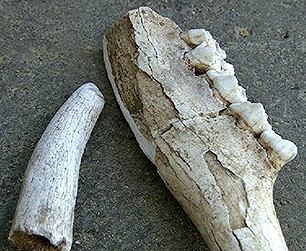 Stone
Age Bones Found In Burgenland: On January 3rd, Burgenland.ORF.at ran a story
reporting the first-ever find of Stone Age animal bones in Burgenland. The bones were found by
Josef Gossy, a businessman and amateur archaeologist who runs the tavern at the Roman-era quarry
near St. Margarethen. Parts of this quarry are still operational but older sections have been
turned into an open air museum and a performance center for opera and passion plays.
Stone
Age Bones Found In Burgenland: On January 3rd, Burgenland.ORF.at ran a story
reporting the first-ever find of Stone Age animal bones in Burgenland. The bones were found by
Josef Gossy, a businessman and amateur archaeologist who runs the tavern at the Roman-era quarry
near St. Margarethen. Parts of this quarry are still operational but older sections have been
turned into an open air museum and a performance center for opera and passion plays.
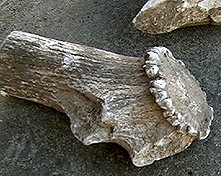 Over
the years, Gossy has made numerous bone finds in the quarry and surrounding hills, with the
latest, according to the National Museum and state archaeologist Hannes Herdits, being about
35,000 years old.
Over
the years, Gossy has made numerous bone finds in the quarry and surrounding hills, with the
latest, according to the National Museum and state archaeologist Hannes Herdits, being about
35,000 years old. Not
surprisingly, the exact location of the site, somewhere in the Rust Hills, remains a secret.
Experts from the Academy of Science are planning a dig at the site to determine whether there
are also traces, in the form of stone tools, of Stone Age people. If so, the site will also
become the earliest known location of "Burgenländer" inhabitation.
Not
surprisingly, the exact location of the site, somewhere in the Rust Hills, remains a secret.
Experts from the Academy of Science are planning a dig at the site to determine whether there
are also traces, in the form of stone tools, of Stone Age people. If so, the site will also
become the earliest known location of "Burgenländer" inhabitation.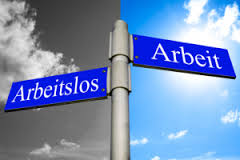 Employment
and Unemployment in Burgenland: Burgenland.ORF.at also reported on Burgenland's
unemployment numbers for December and for 2014 overall. Unemployment continued to rise in
December - but the increase was significantly lower than elsewhere in Austria. Registered
unemployed in Burgenland increased 0.7 percent, well below the nationwide increase of 9 percent
or the increases in any other individual Austrian state.
Employment
and Unemployment in Burgenland: Burgenland.ORF.at also reported on Burgenland's
unemployment numbers for December and for 2014 overall. Unemployment continued to rise in
December - but the increase was significantly lower than elsewhere in Austria. Registered
unemployed in Burgenland increased 0.7 percent, well below the nationwide increase of 9 percent
or the increases in any other individual Austrian state. Update
for book "The Burgenländer Emigration to America": Here is this month's update on
purchases of the English issue of the 3rd edition of Dr. Walter Dujmovits' book “Die
Amerika-Wanderung
Update
for book "The Burgenländer Emigration to America": Here is this month's update on
purchases of the English issue of the 3rd edition of Dr. Walter Dujmovits' book “Die
Amerika-Wanderung
 Der
Burgenländer.” While I thought I would have dropped this monthly update by now, the
continuing interest in the book prompts me to maintain these regular notes... though that could
change with a few months of poor performance!
Der
Burgenländer.” While I thought I would have dropped this monthly update by now, the
continuing interest in the book prompts me to maintain these regular notes... though that could
change with a few months of poor performance!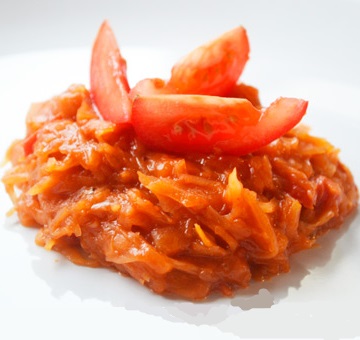 2.2
pounds White Cabbage
2.2
pounds White Cabbage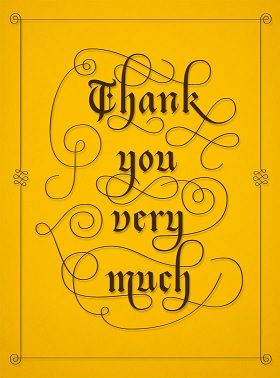 Thank
You Very Much: While watching "Scrooge," the 1970 Albert Finney musical version
of "A Christmas Carol" this past Christmas season, I could not help but smile at the
musical number called "Thank You Very Much." If you have watched the show, you will
recall that it is sung while Scrooge is traveling with the Ghost of Christmas Future and
is performed in celebration of Scrooge's death, though Scrooge does not realize the true reason
for the celebration... he only knows he is the cause of it and is pleased by the many
thanks. A key part of the lyrics are: "Thank you very much! Thank you very much! That's the
nicest thing that anyone's ever done for me."
Thank
You Very Much: While watching "Scrooge," the 1970 Albert Finney musical version
of "A Christmas Carol" this past Christmas season, I could not help but smile at the
musical number called "Thank You Very Much." If you have watched the show, you will
recall that it is sung while Scrooge is traveling with the Ghost of Christmas Future and
is performed in celebration of Scrooge's death, though Scrooge does not realize the true reason
for the celebration... he only knows he is the cause of it and is pleased by the many
thanks. A key part of the lyrics are: "Thank you very much! Thank you very much! That's the
nicest thing that anyone's ever done for me."